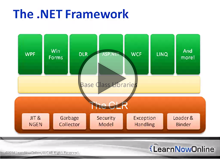Course description
.NET is a Framework from Microsoft, introduced in 2001 that makes it easier to build applications that cross platforms and hardware. It does this by providing a consistent and powerful set of classes and interfaces that abstract away differences of architecture and allow developers to use the right languages and tools that work for them. A large base class library that includes features such as data and file access, user interface features, cryptography and more, opens up the power of the Windows operating system. The applications are run in a safe runtime engine called the CLR, which handles security, memory management, exception handling and more. In this course we will take a look at how the .NET framework is built and what you need to know to make the most of it.
Prerequisites
This course assumes that students understand Visual C# 5.0 syntax, and have a basic understanding of the .NET Framework. No specific experience with Visual Studio 2013 is required.
Learning Paths
This course is part of the following LearnNowOnline SuccessPaths™:
.NET Framework C# Development
Meet the expert
Mike Benkovich delivers technical presentations around the U.S. as a consultant, trainer, and former Developer Evangelist for Microsoft. He has worked in a variety of professional roles including architect, project manager, developer, and technical writer. Mike is also an author of two books, published by WROX Press and APress, that show developers how to get the most from their SQL databases. Since appearing in the 1994 Microsoft DevCast, Mike has presented technical information at seminars, conferences, and corporate boardrooms across America.
Course outline
Overview of .NET
Framework Concepts (19:31)
- Introduction (00:32)
- Goals of .NET Framework (01:21)
- Components of .NET Framework (01:18)
- Common Type System (00:28)
- Many Releases (01:19)
- The .NET Framework (01:07)
- Common terms of .NET (02:08)
- Programming Languages (00:41)
- Visual C# (00:52)
- Visual Basic .NET (00:43)
- C# and VB Evolution (00:45)
- Visual C++ (00:26)
- Visual F# (00:23)
- Considerations for choosing (00:58)
- Deployment and Packaging (00:42)
- Intermediate Language (01:02)
- Demo: Ildasm (04:23)
- Summary (00:13)
LINQ (23:47)
- Introduction (00:31)
- Language Integrated Query (01:35)
- Under the covers (01:08)
- Query Expressions (01:56)
- How LINQ works (01:02)
- LINQ Providers (00:25)
- Demo: LINQ (02:15)
- Demo: Run App (03:03)
- Demo: Bind to other things (01:49)
- Demo: Bind to a database (02:04)
- Demo: Collection of files (04:44)
- Demo: Join Query (02:49)
- Summary (00:20)
Entity Framework (15:43)
- Introduction (00:35)
- Entity Framework (01:10)
- Entity Framework (EF) (00:53)
- EF developer workflows (01:56)
- Demo: Model First (04:04)
- Demo: Generate Database (02:26)
- Demo: Add Entity Basetype (01:42)
- Demo: Database First (02:42)
- Summary (00:11)
EF Code First (16:49)
- Introduction (00:21)
- EF Mapping Capabilities (00:36)
- Data Migrations (00:58)
- Demo: Code First (02:51)
- Demo: Add Controller (02:11)
- Demo: Run Project (02:57)
- Demo: Data Migration (03:02)
- Demo: Deploy Migration (03:39)
- Summary (00:11)
Parallel Dynamic and Async (07:35)
- Introduction (00:23)
- Parallel Computing (01:18)
- Asynchronous (00:40)
- For Example (00:15)
- Async methods (00:24)
- Demo: Async Method (03:58)
- Demo: run code (00:25)
- Summary (00:07)



